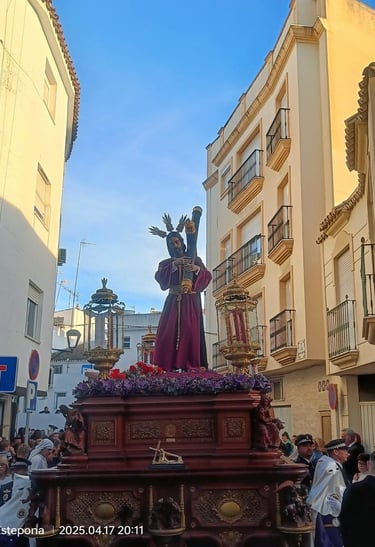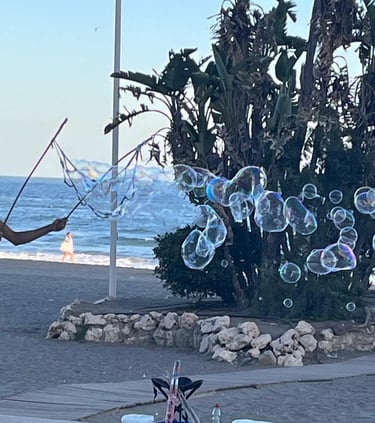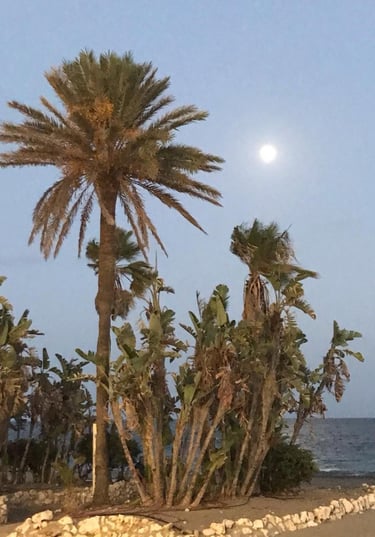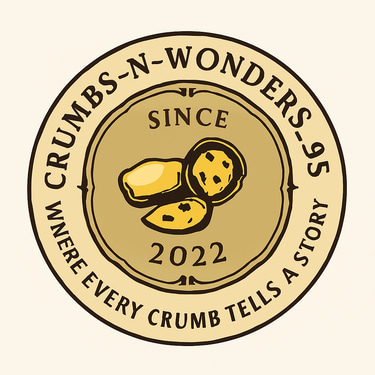Estepona: Where the Soul Meets the Sea
This is Estepona. Not the Spain of postcards and tourist buses, but the Spain that whispers to your soul.
TOUR OF THE MONTH
Wandering Armenian
10/11/202513 min read
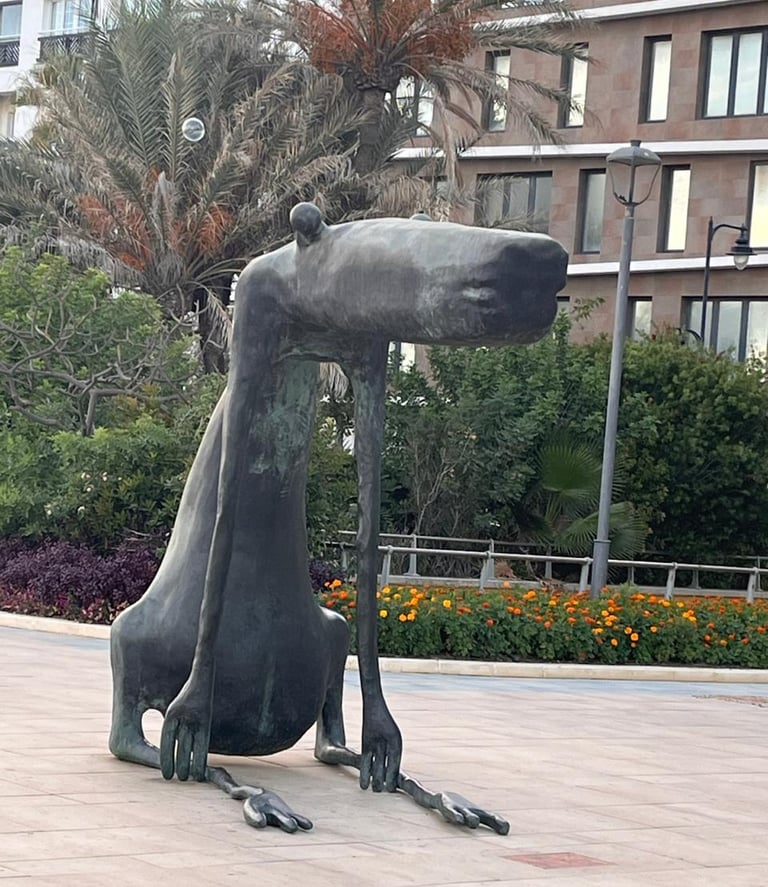

The land itself breathes history. The Sierra Morena mountains guard the north like ancient sentinels. The Mediterranean and Atlantic waters cradle its coasts. And between mountain and sea, humanity has planted its dreams: olive groves that shimmer silver in the wind, vineyards heavy with promise, citrus orchards perfuming entire valleys.
This is where East met West for centuries—where the muezzin's call once echoed across courtyards now filled with church bells, where Jewish scholars, Muslim mystics, and Christian monks once walked the same dusty roads, each seeking the face of God in their own tongue.
II. The Beating Heart: Culture, Soul, and the Andalusian Fire
A. When the Guitar Weeps and the Soul Speaks
If you have never witnessed flamenco in a small Andalusian Plaza at midnight, you have not truly heard music. This is not performance—this is confession, exorcism, prayer. The cantor’s voice cracks open the night, pulling grief and joy from the same well. The dancer's feet hammer the earth as if calling forth ancestors. The guitar—ay, the guitar—weeps and laughs simultaneously.
B. The Language of Shadows and Light
Andalusians speak Spanish, yes—but softened, musical, with consonants that dissolve like sugar in water. Listen carefully and you'll hear echoes: Arabic words that survived the Reconquista, rhythms that remember when this land spoke many tongues.
Faith here is tactile, visible. Saints' statues peer from niches in ordinary walls. Chapels hide in alleyways like secrets. During Corpus Christi, entire streets become carpets of flower petals arranged in sacred geometry. Religion is not abstract theology, it is the smell of candle wax, the weight of a silver cross in a procession, the shared silence of a crowded church at midnight mass.
C. Architecture as Prayer
The Alhambra in Granada doesn't just impress, it stops your breath. Those horseshoe arches in Córdoba's Mezquita create a forest of stone and light that makes you forget whether you're in mosque or cathedral (it has been both). The Pueblos Blancos-white villages clinging to hilltops seem less built than grown, organic as wildflowers.
Moorish influence taught Andalusia to build for beauty and blessing: courtyards with fountains (water as gift and metaphor), azulejo tiles that turn walls into gardens of geometric praise, narrow streets designed to embrace shade. Even humble homes have this: a pot of geraniums blazing red against white walls, a doorway framing a glimpse of inner peace.
III. Estepona: The Hidden Jewel
While tourists flood Seville, Granada, and Marbella, Estepona remains—miraculously—herself. Smaller, quieter, but no less luminous. If Andalusia is a symphony, Estepona is the movement played pianissimo, the one you must lean in to hear, the one that haunts you afterward.
1. Layers Upon Layers
No one knows exactly when Estepona began. As Astapa or Astabbunna, a Phoenician trading post where merchants haggled over purple dye and olive oil three thousand years ago. Romans came, bringing roads and order. Visigoths passed through like a rough wind. Then the Moors, who built watchtowers along the coast and planted gardens that still perfume the air.
In the 15th century, the Christian Reconquista swept through. Enrique IV of Castile claimed the town, but Estepona never became grand or important. It remained what it had always been: a fishing village, a small port, a place where people worked the sea and tended small plots of earth.
That is its blessing. Without the weight of empire or the hunger of conquest, Estepona was free to simply be—to grow slowly, to preserve what mattered, to welcome strangers without losing its soul.
2. Between Mountain and Wave
Estepona stretches along 21 kilometres of Mediterranean coastline, where the sea arrives in shades of turquoise and sapphire that seem impossible, too vivid to be real. Behind the town, mountains rise—the Sierra Bermeja, where rare pinsapo firs grow in forests that feel prehistoric, where eagles circle and silence has weight.
bougainvillea, jasmine—small explosions of colour and scent. Cobblestones bear the polish of countless footsteps: fishermen heading to dawn catches, children running to school, lovers walking hand in hand after dinner.
In the Plaza del Reloj, the town clock keeps its patient watch. The ruins of San Luis Castle stand like a prayer written in stone. And every July 16th, something ancient and alive happens.
4. To Eat in Estepona Is to Taste the Divine
If God speaks through creation, then surely the Mediterranean is one of His most eloquent statements—and Estepona knows how to listen.
The cuisine here is not elaborate or pretentious. It is honest. Walk down to the port at dawn and you'll see fishing boats unloading their catch: sardines still silver and sleek, anchovies, prawns, octopus, whatever the sea decided to offer that morning. By afternoon, those same fish appear in tapas bars—grilled simply with olive oil and sea salt, or fried until golden, or pickled with vinegar and garlic.
The sardine—the humble sardina—is sacred here.
Watch this: At beachside chiringuitos, especially during festivals, they prepare espeto de sardinas. Fresh sardines are skewered on long bamboo sticks and thrust into sand beside driftwood fires. The wood smoke flavors the fish as they roast, fat dripping and sizzling. When ready, they're pulled from the fire, still hot, sprinkled with coarse salt.
You eat them with your hands—no plates, no fanciness—pulling the tender flesh from the bones, licking your fingers, tasting smoke and sea and salt. This is communion. This is the loaves and fishes made real.
Consider: Jesus fed five thousand with sardines (or fish much like them) and loaves. Not delicacies, not imported luxuries—common food, fisherman's food, the daily bread of ordinary people. When you eat espeto in Estepona, you participate in something older than Christianity, older than Rome: the simple grace of taking what the sea provides, cooking it with fire, and sharing it.
Scripture tells us: "Taste and see that the Lord is good" (Psalm 34:8). In Estepona, this is not a metaphor. The sweetness of a local white wine—crisp and cold, tasting of limestone and sunshine. The richness of local olive oil, green-gold and peppery. The burst of a ripe tomato in gazpacho. The char on grilled octopus. The way fresh bread is still warm from the oven breaks open in your hands.
To eat here is to receive the earth's blessing, to honour the hands that caught, cooked, and served, to remember that nourishment is always—always—a gift.
Beyond sardines: gazpacho so cold and bright it's like drinking summer itself. Salmorejo thick as velvet, topped with jamón and boiled egg. Boquerones (anchovies) fried or pickled in vinegar until they're tender and sharp. Pimientos de padrón, those Russian roulette peppers most mild, but one in ten will make you gasp. Desserts like tocino de cielo, "heavenly bacon," a caramel custard so rich it borders on sinful.
Every meal is a small liturgy. Sharing tapas with friends. The unhurried conversation over wine. The way restaurants don't rush you, because eating is not transaction it is relationship.
IV. Economy and the Balance of Welcome
Estepona was never rich. Its wealth was simpler: fish, olives, citrus, trade. Phoenician merchants likely started it—this was always a place of exchange, of goods moving between cultures.
Through centuries, life continued in this rhythm: fishermen, farmers, artisans, small traders. Then came the late 20th century and the Costa del Sol boom. Suddenly, this sleepy coast became coveted. Towns exploded into resorts.
Estepona made a choice. Instead of surrendering to development, it invested in itself: urban renewal that respected history, cultural projects, careful growth. The Parque Central Bulevar, green spaces, pedestrian zones, museums, the stunning mural route that turned ordinary walls into open-air galleries.
Now the economy balances: tourism brings visitors who seek authentic Spain, not generic beaches. Real estate attracts buyers drawn to beauty and tranquillity. Local businesses thrive—cafés, restaurants, artisan shops, markets. The Sunday market still buzzes with locals buying produce and cheese and olives, not souvenirs.
The challenge remains: How to welcome without being consumed? How to share without selling out? So far, Estepona walks this line with grace.
Tourists come for the 21 kilometres of beaches, the 320 days of sun, the proximity to Málaga and Gibraltar. But they stay, return, recommend—because Estepona offers something rarer than sunshine. It offers presence. The chance to slow down, to notice, to belong (even briefly) to a place that still knows itself.
V. Through the Wanderer's Eyes: My Estepona
I arrived at the threshold of evening when the light turns everything gold. The sea lay calm, whispering secrets to the promenade palms. I left the coastal road and entered the old town as one enters a sanctuary with reverence, with curiosity, with the door of the heart ajar.
Whitewashed walls glowed. Flowers rioted from balconies geraniums, bougainvillea, jasmine—each colour more impossible than the last. The alleys twisted and turned, revealing glimpses: a cat sleeping in a patch of sun, an old woman watering plants, a couple laughing over something private. I followed the sound of a guitar and found a small plaza where a man played alone, eyes closed, fingers finding notes like prayer finds words.
At a corner café, I ordered tinto de verano—wine and lemon soda over ice, the drink of summer, simple and perfect. The owner, José, brought olives without asking. His face was weathered like driftwood, beautiful with age. We spoke my broken Spanish, his patient answers.
He told me: "My father fished. His father fished. The sea takes and the sea gives. Always we ask the Virgin to watch over us." He gestured toward the street, toward the harbour invisible from here but present in every conversation. "Now my son works on computers. He helps tourists book hotels. Different world. But every July, for Virgen del Carmen, he comes. He carries the platform. He remembers."
I spent days dissolving into Estepona's rhythm. I ate fried anchovies at sunset, the fish tasted so fresh they tasted like the sea remembered paradise. I walked the mural route at night when the art glowed under streetlights. I climbed to watchtower ruins where wind and view and solitude converged. I attended a flamenco performance in a small square twenty people, the singer a woman older than time, her voice breaking and soaring, making strangers weep.
One afternoon, I hiked inland toward the Sierra Bermeja. Pine scent thick as honey. Cicadas creating their eternal symphony. And in a clearing, I stopped. Below: the Mediterranean, endless blue. Behind: mountains. Around: this improbable beauty. I thought of the Psalmist: "I lift up my eyes to the mountains—where does my help come from?" (Psalm 121:1)
Here was the answer: from this, from all of this, from the overwhelming evidence that creation is gift, that beauty is covenant, that we are held by something larger than ourselves.
VI. What to See, Where to Go, How to Be
Old Town & Murals: Wander without agenda through the Casco Antiguo. Follow the mural route street art integrated so naturally it feels like the buildings were born with these images.
Orchidarium: Step into this garden sanctuary in the town's heart. Breathe. Orchids like prayers, each one unrepeatable.
Historic Walking Tour: Join the 1.5-hour tour to hear the stories the Roman finds, the Moorish towers, the Christian chapels, the modern renaissance.
Beaches: Playa del Cristo is intimate, cove-like. Playa de la Rada stretches long and golden. Walk the promenade at dawn or dusk when the light performs miracles.
San Luis Castle Ruins: Climb up. Stand where soldiers once watched for pirates. Now you watch for eternity.
Virgen del Carmen (July 16): If your timing aligns, witness this. It's not spectacle it's sacrament.
Sierra Bermeja: Hike inland. Find the pinsapo forests, ancient and hushed. Listen to what silence teaches.
Markets: Sunday market for produce, local cheese, olives, conversation. Artisan shops scattered through town ceramics, leather, paintings.
Tapas Pilgrimage: Don't plan it. Just start walking. Let hunger and curiosity guide you. Share plates. Talk to strangers. This is the way.
VII. Reflections and the Traveler's Blessing
"The heavens declare the glory of God; the skies proclaim the work of his hands." (Psalm 19:1)
Beloved traveller, Estepona taught me what I keep forgetting: that the sacred is not separate from the ordinary, that God's fingerprints are on salt-weathered stones and sardines roasting over fire and the way light breaks through narrow streets at exactly the right angle.
We live in speed and screens, in transactions and transit. We move through the world like ghosts, seeing but not perceiving, hearing but not understanding. But places like Estepona call us back to our senses, back to the presence, back to the truth that we are here, now, alive.
When you walk these streets, walk slowly. Notice the woman who whitewashes her wall every spring. Notice the fisherman mending nets by the harbour. Notice the way the evening calls to prayer though silent now for centuries still seems to echo in the archways the Moors built.
Taste the sardines and remember: God multiplied fish to feed the hungry. The sea is generous. The earth provides. Every meal is Eucharist if you receive it as gift.
Listen to flamenco and hear all the voices that have cried out across generations in grief, in joy, in defiance, in praise. This is human music, which makes it holy music.
Watch the Virgen del Carmen procession and understand faith is not belief system it is relationship, tradition, the way a community says, "we are bound to each other, to this place, to what came before, to what comes after."
"Be still and know that I am God." (Psalm 46:10)
In Estepona's quiet hours at dawn before the shops open, at siesta when everyone rests, at twilight when the sea receives the sun practice this stillness. Let the town teach you, its place. Let beauty enter without effort. Let yourself be held by a place that has held so many before you.
And when you leave because we always leave carry this with you: the taste of salt and smoke, the sound of footsteps on ancient stones, the memory of light on water, the echo of a song you cannot name but will never forget.
"The Lord bless you and keep you; the Lord make his face shine on you and be gracious to you; the Lord turn his face toward you and give you peace." (Numbers 6:24-26)
May your journey to Estepona be more than tourism. May it be pilgrimage. May you find there what you didn't know you were seeking. And may you return home changed not because you went somewhere exotic, but because you met yourself, met beauty, met the sacred in the ordinary, met God in a small Spanish town where the sea still sings its ancient song.
Go gently. Go gratefully. Go with eyes open to wonder.
Estepona: Where the Soul Meets the Sea
The Invitation
Close your eyes. Imagine cobblestones still warm from the afternoon sun beneath your feet. The scent of jasmine and salt air intertwines with the distant strum of a guitar. Whitewashed walls glow like pearls in the golden hour, and somewhere perhaps from a hidden courtyard a woman's voice rises in flamenco, raw and ancient, singing of longing and homecoming. This is Estepona. Not the Spain of postcards and tourist buses, but the Spain that whispers to your soul.
I. Andalusia: Where Civilizations Dance in the Dust
Andalusia is not merely a place—it is a living psalm, a geography of memory where every stone remembers who touched it, every archway frames a thousand sunsets witnessed by Phoenician traders, Roman centurions, Moorish poets, and Christian pilgrims alike.
Stand anywhere in this southernmost corner of Europe and you stand upon layers. Beneath your feet: Bronze Age settlements. Around you: streets named in Arabic (Guadalquivir—"the great river"), buildings bearing Moorish arches beside Gothic spires, the DNA of civilizations braided together like a fisherman's rope.
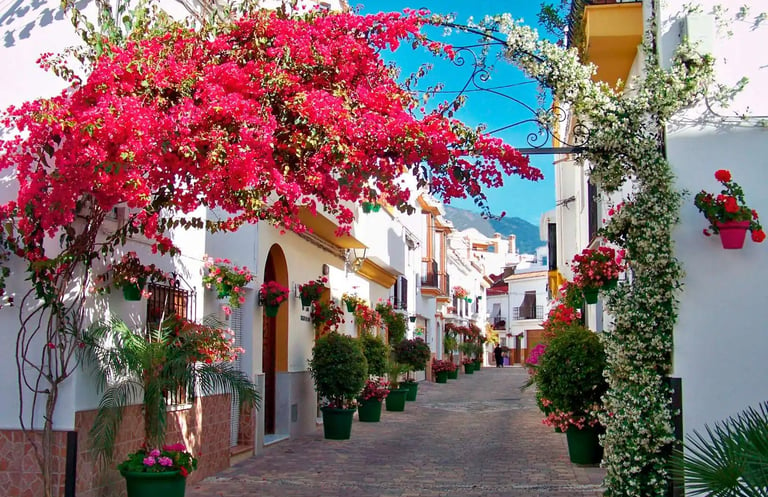

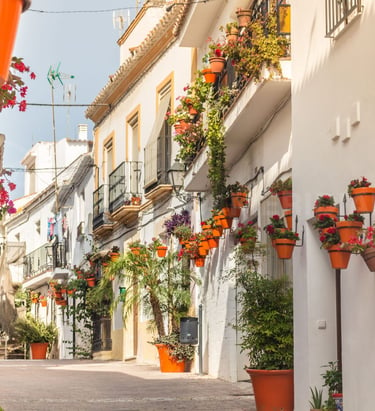

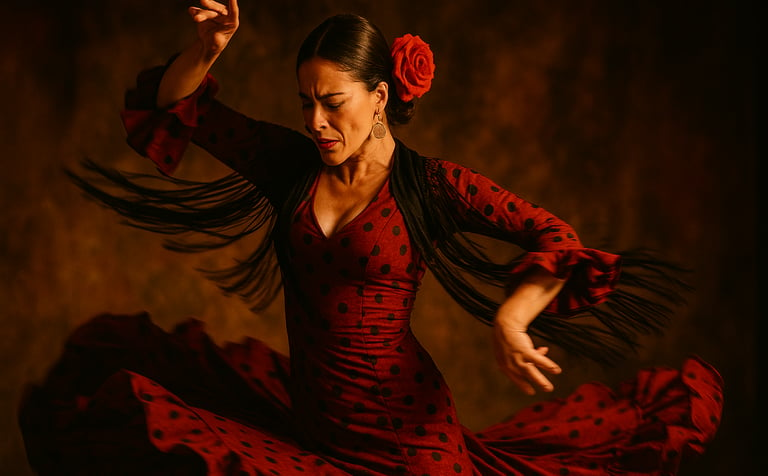

Cultural Heart: Flamenco dancer in motion - capturing the soul and passion
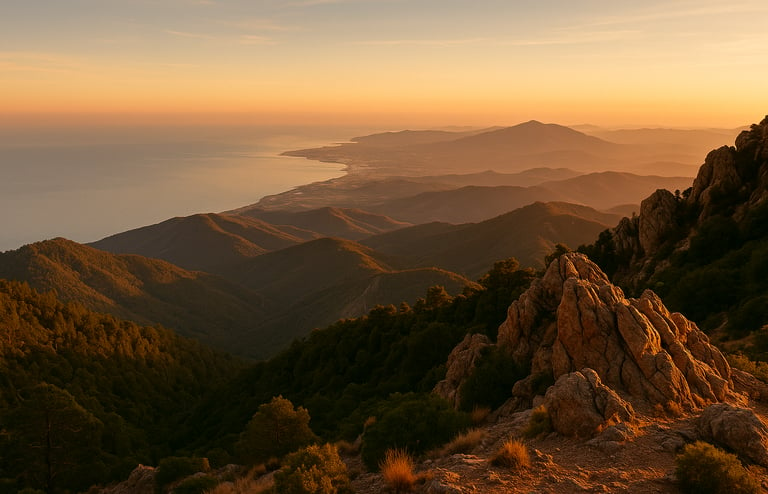

The climate is a gift: more than 320 days of sunshine annually, winters so mild that January feels like spring elsewhere. Summers blaze golden and dry, perfect for long afternoons that dissolve into cooler evenings when the whole town seems to exhale.
Around 70,000 souls call this home, though in summer the population swells with visitors. Yet even then, Estepona resists the frenzy of neighbouring resorts. Here, growth has been gentle, thoughtful. New promenades and parks, yes—but the old town remains intact, its heart still beating in the same rhythm.
3. Faith, Tradition, and the Things That Endure
Step into Estepona's old quarter and time doesn't stop—it layers. These whitewashed walls have been whitewashed for centuries, each generation adding its coat. Balconies cascade with geraniums,
View from Sierra Bermeja mountains overlooking the Mediterranean
Flamenco was born in the margins: among the Gypsies, the Moors who refused to forget their songs, the Jews who carried melodies in their bones, the Andalusian peasants who worked estates beneath merciless suns. From this crucible of suffering and resilience came something transcendent. When you hear it, you understand this is what it sounds like when the soul refuses to be silent.
Beyond flamenco, life here pulses with ritual and celebration. During Semana Santa, hooded penitents carry statues of the Virgin through streets perfumed with incense and orange blossom—ancient pageantry that transforms entire towns into open-air cathedrals. At ferias, young and old dance sevillanas until dawn, the music infectious, the joy communal.
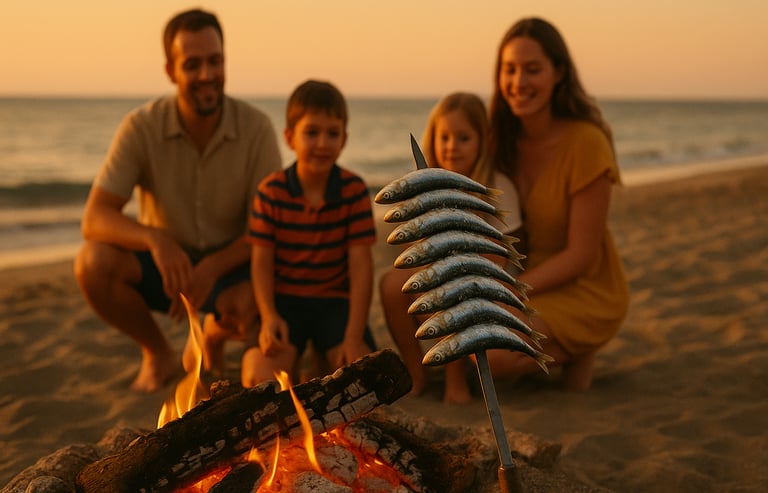

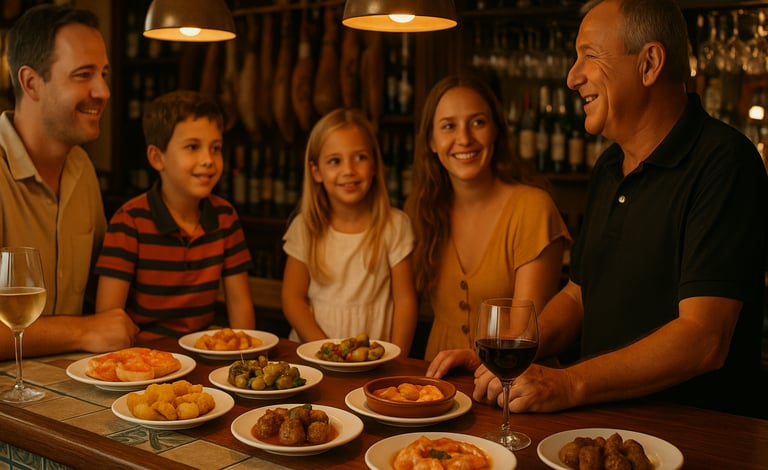

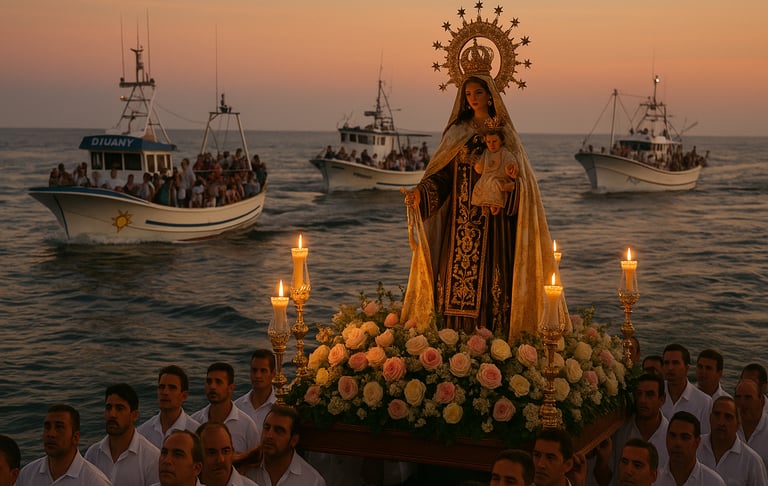

The Virgen del Carmen procession is not tourism—it is homecoming. The statue of the Virgin, patron saint of sailors, is carried from her chapel through streets lined with families who have participated in this ritual for generations. They carry her to the sea itself, where fishing boats—decorated with flowers and flags—wait. The statue is placed on a boat and taken out onto the water, blessed and blessing.
Watch the faces of the fishermen as they follow the Virgin into the waves. This is not quaint folklore. This is a living covenant between people and sea, between faith and livelihood, between past and present. Many of these men still fish these waters. The sea feeds their families and has claimed their ancestors. The Virgin is invoked not as a distant deity but as a mother, protector, the one who understands. Faith here is woven into the fabric of dailiness: the way a grandmother crosses herself before cooking, the way a shopkeeper keeps a small icon of San Antonio by the register, the way even secular Spaniards fall quiet during Semana Santa processions.
Sacred Tradition: The Virgen del Carmen procession with fishing boats
